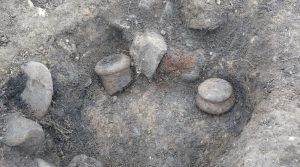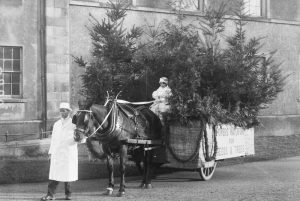Ever come across a strange stone with a hole in it in a graveyard or standing tall in a field and wondered about its significance? We discuss the many traditions and beliefs associated with holed stones, as well their uses and potential date.
Ireland’s holed stones
Holed stones, while relatively plentiful in Ireland, are enigmatic monuments. Occurring in a variety of shapes, sizes and stone-types, they are upright monuments typically featuring a single circular or subcircular hole that penetrates fully through the stone. The holes themselves vary enormously in size. About 40 holed stones have been recorded by the National Monuments Service as part of their archaeological survey of Ireland; however, many more – especially smaller monuments in graveyards – have not yet been included in the survey.
A D V E R T I S E M E N T
Holed stones: customs, beliefs & uses
Holed stones are poorly understood but they reflect a wealth of local traditions and folklore.
Healing powers
Several holed stones were believed to have the power to heal infants and children. For example, up until the mid-19th century, sickly children were passed through the large hole at the top of the stone called “Cloch an Phoill” (“Stone of the Hole”) in the townland of Aghade, near Tullow, Co. Carlow, in the belief that this act would bring about a cure.
Sign up to our newsletter
Other holed stones were said to protect pregnant women. The rituals involving these stones often used rags, cloths or ribbons. For instance, in the mid-19th century, John Windele recorded that pregnant women “nearing their confinement, used to draw cloths through the hole” of the Cloch na Peacaibh (“Sinner’s Stone”), which is sited near the ruins of Kilquane church, south of Mallow, Co. Cork, “in order to ensure a favourable delivery”.
Some holed stones operated as sundials and their holes were designed to hold the gnomon – a metal or wooden projecting pin – in place, which would cast a shadow on the face of the sundial. Limerick antiquarian T.J. Westropp was informed by a fisherman in 1878 that cloths were drawn through the holed stone sundial at Mainistir Chiaráin on Inishmore, the largest of the Aran Islands. In this instance, it was believed that these cloths then held curative properties for sore limbs.

>>> READ MORE: Sundials: telling the time in medieval Ireland
In fact, even to this day, ribbons, strings and small cloths are often tied around the holes of the smaller holed stones found in many early church sites, such as at Finlough, Co. Clare.

An ogham stone at Kilmalkedar early church site in Co. Kerry features a hole towards the top of the pillar. In 1891, Dublin antiquarian W.F. Wakeman recorded that the holed ogham stone was believed to have healing powers for those with chronic rheumatism. People were expected to circle the stone three times while reciting specific prayers.

Swearing and oath-taking
One of the stations of the Glencolmcille pilgrimage in the townland of Farranmacbride, Co. Donegal, is a cross-inscribed holed stone called “Cloch an Aoineach” (“The Stone of the Gathering”) with the hole piercing the centre of the cross. Traditionally, engaged couples would entwine their fingers inside the hole, one on either side of the stone. Another ritual attached to this stone involves pilgrims encircling the stone three times as they renounce the world, the flesh and the devil. It is believed that those in a state of grace experience a vision of heaven when they look through the hole.
In relation to a sundial at Kilmalkedar, Margaret Gatty (1809–73) wrote,
“In former days, when a priest could not be had, it was a common practice amongst the Irish for the bride and bridegroom to put each a finger in the hole, and pledge themselves in the presence of witnesses. This engagement held good till a priest was procured to solemnize the marriage …”
A D V E R T I S E M E N T
However, this sundial’s gnomon hole does not penetrate all the way through the stone and it is commonly believed locally that Mrs Gatty was referring here to customs associated with the aforementioned holed ogham stone on the site.
Similarly, the Doagh holed stone in Co. Antrim became known as the “Love Stone” or “Betrothal Stone” because of its reputation for exchanging marriage vows; this tradition survives up to the present day. A large holed stone just outside the eastern bank of a ringfort in the townland of Caherurlagh, on the Sheep’s Head peninsula in Co. Cork, is known locally as the “Marriage Stone” and similar rituals are associated with it. It is also said to have healing powers.

The holed stone at Castledermot, Co. Kildare, is known as the “Swearing Stone” or “Leac na Mionn” in Irish (“Stone of the Oaths”). This granite slab is carved with a ringed cross and bears a circular hole in the centre of the cross-head. This upright stone sits on a low stepped base set firmly into the ground in the graveyard of an early medieval church site. Given its name, it is highly likely that this stone was used to swear oaths, seal promises and make deals. The fingers of two individuals can easily touch at the centre of the perforation.

The so-called “Bargaining Stone” on Iniscealtra (Holy Island), on the River Shannon in east Clare, is a very unusual monument that does not resemble the other holed stones in terms of its morphology. It comprises three recumbent slabs (a large base stone with two smaller stones placed on top) with a channel running along its long axis. It is possibly a mushroom stone, its unusual shape having been formed by past lapping waves due to its lakeside location.

Up until the mid‐20th century, locals used the Bargaining Stone on Iniscealtra in a similar manner to the holed stone at Castledermot to seal promises by joining hands through its long channel. With the increase in tourism to the island over the past three decades, the stone is again being used to renew marriage vows.
A D V E R T I S E M E N T
The common siting of holed stones at church sites makes it extremely likely that local priests or other holy men oversaw oath-taking rituals. At early church sites, the communities gathered together on saints’ feastdays and important holy days to undertake the “rounds” or “stations” as part of “pattern” day celebrations. But these events were also used as opportunities to swear oaths, seal deals and bind contracts, and no doubt the holed stones formed a central part of such ceremonies. The stones could also have been used to secure tribal alliances or may have even played a role in king-making ceremonies.
Gravemarkers and other uses
Shorter, smaller examples of holed stones were often used to mark graves in medieval church sites and cillíní (children’s burial grounds). It has been suggested that those marking the graves of infants could reflect beliefs in Limbo and the difficulties of childbirth.
Some historic accounts theorize that the taller holed pillar stones could have been used for securing prisoners and as whipping posts. In more recent times, some holed pillars operate as gate posts and scratching posts.
Interestingly, the townland of Hurlstone (Baile na Cloiche), in Co. Louth, is named after a holed stone. In the early 19th century, it was believed that this stone (now 1.7m high but originally taller) was used as a goal for hurling games and that there was a similar stone on the hill about a mile to the southeast.
Date of holed stones
Some holed stones seem to date to the Iron Age or earlier in the prehistoric period and these are generally large monuments featuring particularly large holes. For example, it is commonly believed that Cloch an Phoill in Co. Carlow may have formed part of a megalithic tomb; its hole is so big, it could apparently accommodate infants and small children.
Sign up to our newsletter
However, the vast majority of holed stones occur on ecclesiastical sites and probably date to the medieval period (c.5th–16th centuries AD) or later. It is likely that most cross-inscribed holed stones, especially those occurring on early church sites or at holy wells, were products of the early medieval period. This includes Castledermot’s swearing stone, the holed ogham stone at Kilmalkedar, the sundial at Mainistir Chiaráin and many more.
A D V E R T I S E M E N T
Some holed stones are linked to post-medieval customs associated with the penal period. It has been suggested that such stones were used to exchange marriage vows at a time when priests were on the run and not always readily available. A priest would later offer the sacrament of marriage to the couple who had already promised themselves to each other publicly via a betrothal ritual involving the holed stone. Some of the smaller holed stones may simply have been chosen on account of their unusual appearance as gravemarkers in the post-medieval and early modern periods.
Subscribe to the Irish Heritage News newsletter and follow us on Facebook, Twitter and Instagram for all the latest heritage stories.
A D V E R T I S E M E N T
READ NOW
➤ Sundials: telling the time in medieval Ireland
➤ Custom of sending Valentine cards temporarily died out in early 1900s Ireland
➤ St Gobnait: patron saint of ironworkers, beekeepers and Ballyvourney
➤ How Our Lady’s Bed on Church Island protected expectant mothers


















